Detailing Tips for Off-Road Vehicles
Cleaning your off-road truck or SUV the right way
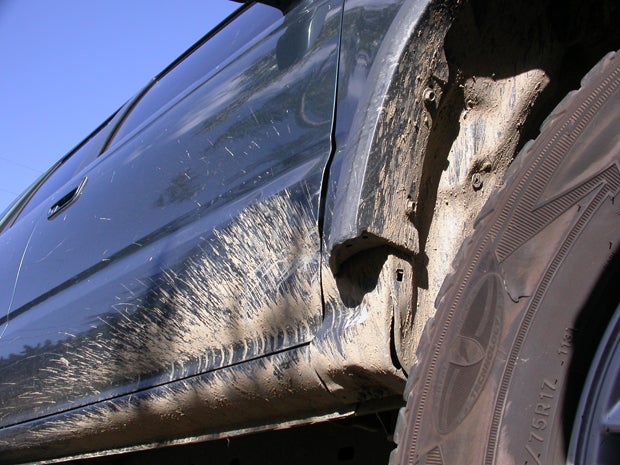
Most off-road, trail and crawling rigs don’t get cleaned too often, but they should get cleaned. Now, while most of your dirt and tire buddies would make fun of you for doing anything more than the spray-n-brush at the local coin-operated you-wash, admit it – deep down inside, you wouldn’t mind doing a decent job of washing your truck. We’re not talking show-and-shine clean, just proper detailing for a lumpy truck. It’s not just about clean, after all: that washing is a time to bond with your truck, like spending the afternoon with your greasy 3600-pound kid. Might as well do a decent job of it.
Now, if you think back, you’ll remember some of the questions that popped into your head the last time you gave your rig a proper wash. What kind of soap should I be using? Can I overwax for extra protection? Am I supposed to take special care of powder-coated surfaces? What do I do about automotive rubber parts like boots and bushings? Do I lube up the knobbies with tire juice or just clean ‘em? Can I get rid of the haze on the headlights? What do I do about my canvas top? How about the plastic windows? Is there any point to vacuuming the interior?
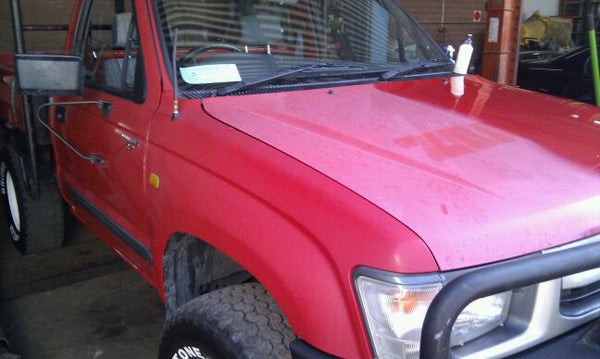 |
There are a few basic car-cleaning rules that are a must for dirty trucks:
-If you break a sweat while car washing, you’re working too hard – you’re cleaning dirt, not digging a ditch. This should be an accurate process, not a powerful one.
-Speaking of, your aim matters. Car care chemicals are often formulated to clean a part of a vehicle that is adjacent to a part that the same cleaner should have nothing to do with. These chemicals are surface-specific.
-Follow instructions. Some cleaners and chemicals need to be wiped off quickly, others should be allowed to sit. Others want to be rubbed on one way, while others need a special applicator.
-The time for cleaning is the time for inspection. How many times have you finished washing and started fixing something you noticed while washing?
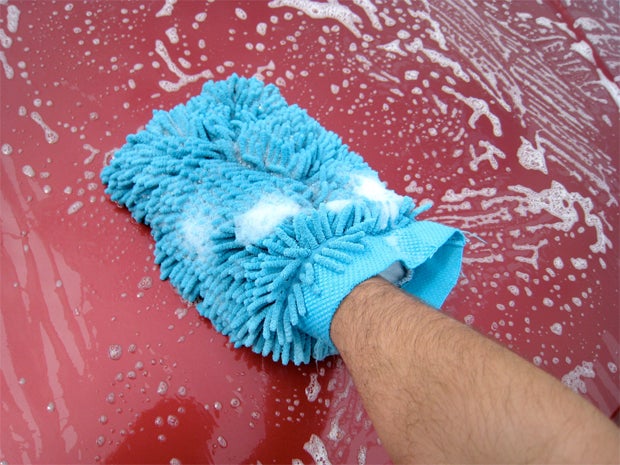
The Car (and Truck) Soap Question
We went to an expert on this one, checking Mother’s Polish detailing website (detailguide.com) for what soaps to use, and when. Easy answer: car-specific soap, all the time. Any good automotive-cleaning soap is going to be formulated for automotive use, which means it won’t strip the wax or greases that most vehicles are full of, and they are also good at breaking down organic matter like bugs and bird poop. Also, a good automotive soap can be mixed into extra-strength batches for pretreating an extra-filthy front end or lower panels that need some extra love, or used straight for spot-treating really bad dirt and stuck-on messes.
Note: the soap you keep in the kitchen for the dishes needs to stay in the kitchen. Dish soap is designed to break down the greases and waxes commonly found in the food we eat, and those are a lot like the greases and waxes that keep your truck lubricated and protected.
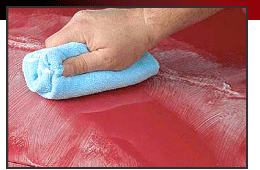 |
Wax On?
Wax protects. Wax on crummy paint protects it from becoming crummier, and from the sun, nasty weather, corrosion, flaking, etc. You don’t need a 100th-percentile application that makes your truck paint shine like a mirror, but a fresh layer of either synthetic or carnauba-based wax will keep a protective layer – the hard candy shell – over the sheet metal on your truck. A clearcoat that’s flaking will flake slower if it has a coat of wax on it (and might not have flaked at all if it had coats of wax on it over more of its lifespan).
Depending on how much time your trail rig spends in the sun, you’ll need to rewax the paint once or twice a year. Don’t overthink the process – once you’ve washed your truck, get it in the shade and get a coat of wax on it and off it. If you’re coating paint that’s seen better days, be gentle while you work in the wax. A spray wax – which requires less rubbing – can be ideal for protecting failing clearcoats from wax-on application. Also, don’t overwax. One coat at a time, applied thin and thorough, and chased with a second coat if you want to be sure you didn’t miss any spots, will last as long as (and be easier to buff out) than a thick coat. We found a lot of good thinking about this in the “Auto Geek Online” forums (autogeekonline.com).
Polish and Clay Bar for Off-Road Paint
Wellllll, if you’re sticking to the “I don’t have time to bleed” method of truck detailing, you’re not going to bother polishing paint (the smoothing process that precedes waxing) or working it with a clay bar (the sneaky little wad of clay that pulls the worst offenders out of your paint prior to polishing). However, both are legitimate paint-care maneuvers that net real benefits to paint that hasn’t checked out yet. Mother’s detail guide (detailguide.com) and Griot’s online detailing videos (griotsgarage.com) have many details about these detailing techniques.
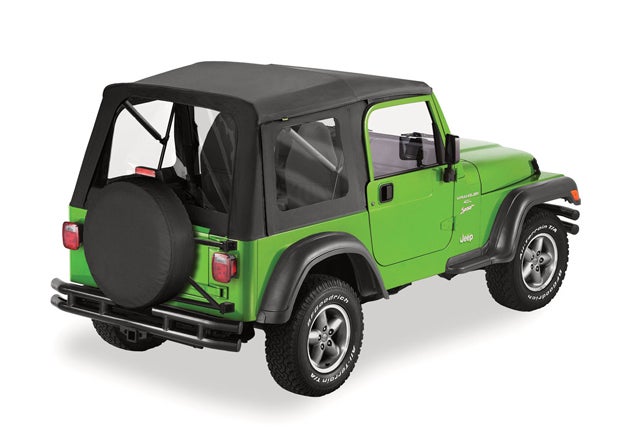
Fabric Tops and Canvas Back Covers
Commonplace on Jeeps and FJs, as well as growing in popularity as a fabric topper for open-back rigs like 4Runners and Broncos, canvas and synthetic fabric tops are not like the painted and/or rusted metal on the rest of your truck. Fortunately, the cleaning process is relatively simple, with the same soap, but it just needs a different technique. Car-wash soap can be used – a stronger than normal mix helps with deeply impinged dirt – and you can pre-treat stains and stuff like bird poop with undiluted car soap. Use a soft brush, preferably a natural bristle, and gently agitate with that thick mixture of suds. Work in the direction of the seams. Remember, if you’re breaking a sweat, you’re using too much force. After a top dries, fabric and vinyl-friendly preservatives are supposed to be good for sealing the top material.
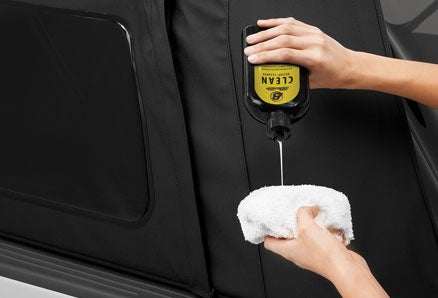 |
A type of old-school fabric-top cleaner you should probably avoid are the bleach-based chemicals your dad used to use on his drop-top Chevelle. They’re strong stuff, and they’re very fabric-specific (as in white-only). Besides, bleach is corrosive to fingers and fabric and makes everything smell like a Laundromat.
As for plastic windows on these tops, gentle is the word. Finesse is the word too, if you’re fresh out of gentle. That plastic can be dry and brittle, and even when new, it’s not the strongest stuff. Use a plastic polish (which may be the unholy marriage of tire protectant and metal polish) and work the window in the same fashion you would wax auto paint. The techniques that works on clear plastic windows apply to clear hard plastic all over a vehicle, so you might touch up your signal lenses while you’re at it. Mother’s Polish suggested their Mag & Aluminum Polish for significantly yellowed plastics, but also said not to let it sit – rub it on, buff it off.
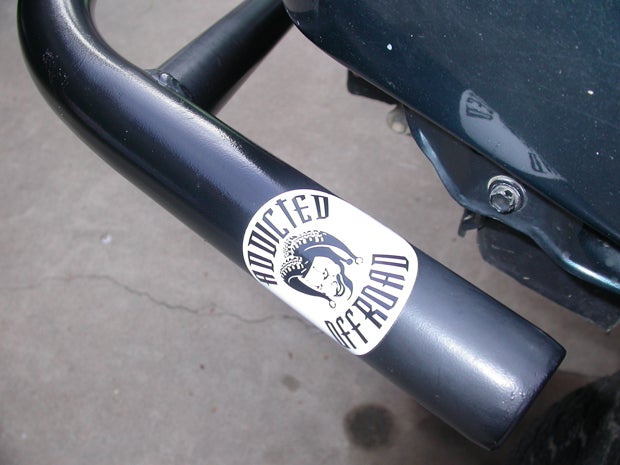
Care and Feeding of Powdercoated Surfaces
Joke’s on you – there ain’t much. Powdercoating is still a great way to protect metal with a durable, colorful coating, and it’s easy to clean. We chatted with the folks from Powder1 in El Cajon, CA (powder1.com), who’ve been doing the shake-n-bake thing since before California elected the only governor who’s killed an alien. They told us that you give powdercoated surfaces the same care that you would automotive paint: soap and water, pretreating with a strong mix if it’s a bumper that’s littered with the carcasses of insects or birds or private aircraft, and you can wax powdercoated surfaces like paint.
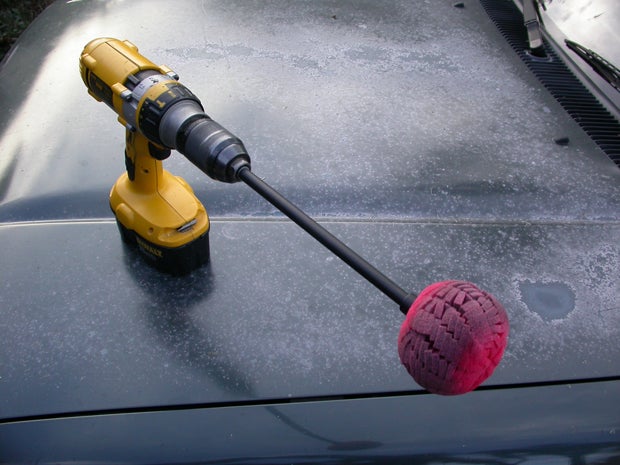
If you’re hoping to restore a bit of lost glory to a faded powdercoat, Powder1 suggested a cleaner wax (which has a slight polish in it), which can improve the luster and color of powdercoating. We also saw a drill-powered foam ball in the Mother’s detail guide that might work for applying cleaner wax to the curved and welded surfaces of a powdercoated bumper. The Powder1 guys also suggested that you can polish powdercoats like you’d wet-sand paint (the whole color-sanding routine) if you’re looking to further improve the appearance of a powdercoated bumper, wheel or cage.
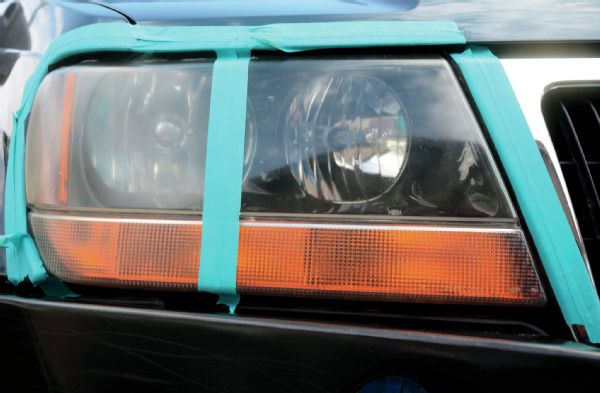 |
Hazy or Yellowed Headlights Can Be Cleaned and Cleared
Okay, this one comes right out of the Mother’s catalog – they make a headlight polishing goo, and there’s a kit if you want to use a power drill to buff them mechanically. Surely, theirs is not the only plastic polish that will work, but their detailing guide was full of good information, so we’re running with it. The lens cleaner/machine-polisher kit is called “NuLens,” and it comes with a specific formulation of PowerPlastic that we suspect is thicker so it’ll stay on the polishing pad. If you’re an old-school glass headlight guy, they make a glass polish too.
How Do You (or Do You?) Apply Protectant to Your Tires?
This is a fun question, with a two-sided answer. Yes but No. Trail and rock-use tires will benefit from surface applications that help preserve the petrochemicals in the tires, just like any street tires. That said, there is such a thing as too much tire juice (especially on tires that are expected to use their sidewall on the trail), and a surface that’s made slippery instead of being kept pliable will be more likely to slip than grip a rock. Duhh. Use tire protectant sparingly, in a thin application that coats, but doesn’t drown the sidewall.
Keep in mind, there are two kinds of tire treatments: the ones that keep the surface of tire sidewalls soft and rubbery (and thusly help that surface protect the inner tire), and the ones that penetrate the surface to repair/restore dried out tires. The more a tire-prep chemical penetrates (usually ones that are called “restorative” or “rejuvenating”), the more likely it is to be inappropriate for hard-working trail tires. In fact, if you’re looking to “restore” a set of tires on a trail rig, those tires are probably too dried out for hard use on the trail. Ask any off-roader, when tires dry out they stop being awesome, and then become a hazard. Tires are too important to the function of a truck in the dirt to let them dry out, so maintain them while you use them, but don’t try to save them with a restorative that is meant for the show-and-shine crowd.
Cleaning and Treating Other Rubbers on Your Rig
There’s a lot of rubber on a truck – everything from CV boots and hoses to suspension bushings and door seals. Some parts, like those boots or gaskets that seal a door to a fender, benefit from flexibility and longevity, so wiping them down with a protectant isn’t a bad idea. An old man we knew used to rub down the door gaskets with a silicone lubricant, just to keep ‘em lithe.
Other truck parts, like bushings, get really squishy, noisy or start behaving weirdly if you apply slippery substances to them in an effort to keep them young. So long as they’re not flaking, cracking or crumbling, rubber parts of the structural or load-bearing sort should be checked regularly, made sure they’re generally clean and free of as much grit as possible, and replaced if they break down, but not squirted with goo.
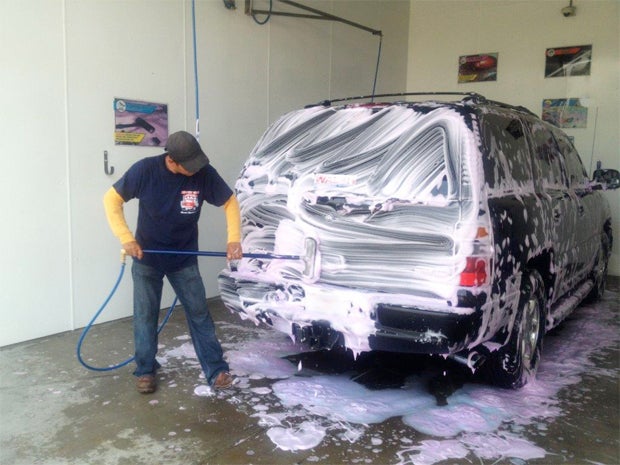
Use the Self-Operated Coin-Wash Carefully
There are lots of exposed parts on lifted vehicle. Don’t blast grease and lubrication out of where it needs to stay. As you’ve probably noticed, even the pressure of your garden hose, when nozzled, can flush out sticky stuff like grease. Meanwhile, the PSI (water pressure – pounds per square inch) of a typical coin-op sprayer at the you-wash is set in the 1000-1800 psi range, but according to “Talk Car Wash” (a coin-op car wash operators’ forum: talkcarwash.com), anything over 1200 psi can damage automotive paint. Most coin-op operators don’t want to attract the mud-and-rocks crowd with powerful rinsing pressure anyway, but if you find enough pressure to clear the trail from your wheel wells, you’re also dealing with enough pressure to remove all the lubrication from suspension and driveline parts. Use your head when pointing the stream.
More Truck Cleaning Dos and Don’ts
- While you’re at it, don’t point the focused hose nozzle (the “Stream” setting) at a spot of dirt or tar on the paint of your truck. That’s enough water pressure to strip wax, and can even damage a clearcoat. Pretreat the offender instead.
- Smart aim is essential when using degreasers. There are parts of a hard-working trail truck that need to stay greasy, especially underhood.
- Vacuuming: it’s not just a river in Egypt. The dirt and grit in your carpets and seats is like a knife fight in the fibers and materials that make up soft parts, and it also gives moisture a place to hide. Vacuuming is a quick and effective way to keep your interior from dying an early death.
- We’ll say it twice: only use dish soap it you want to strip grease and wax, otherwise, keep that crap in the sink.
- Find a beater sponge that’s meant to use only on dirty parts – suspension bits and such – and keep it around for that purpose. An old kitchen sponge is also great for applying tire products or fabric top conditioners. When you’re done, put it in a baggie, label the baggie as to which chemical the sponge was used for, and it’ll be ready to go for the same duty the next time you need it.


 Your Privacy Choices
Your Privacy Choices